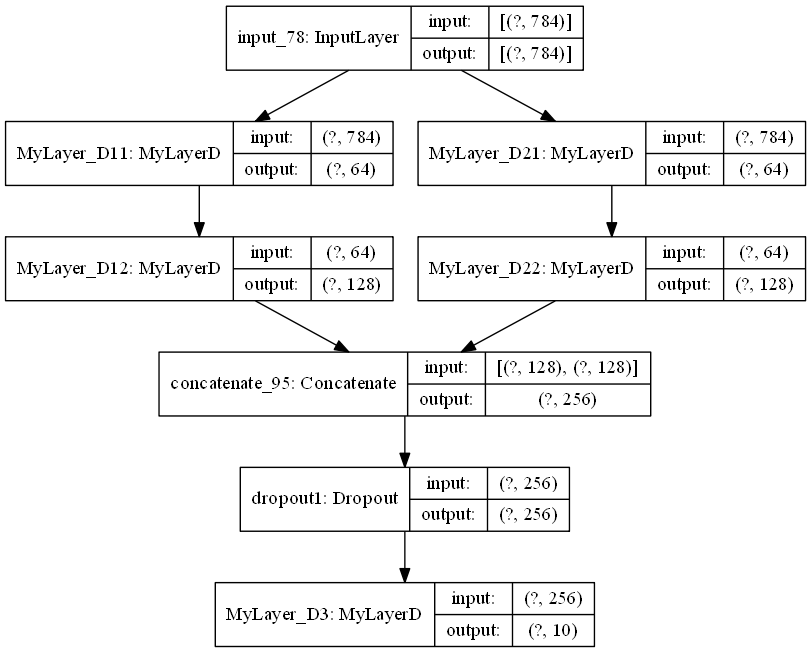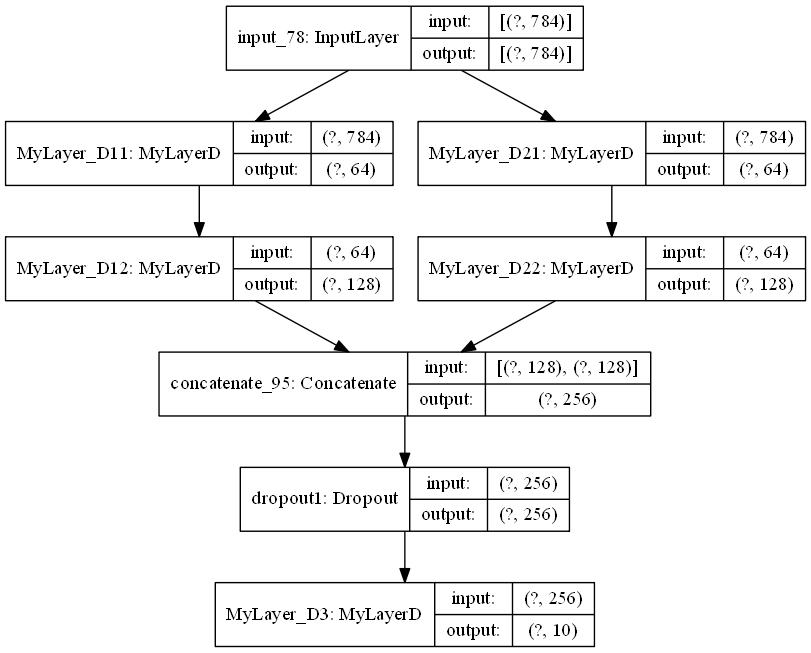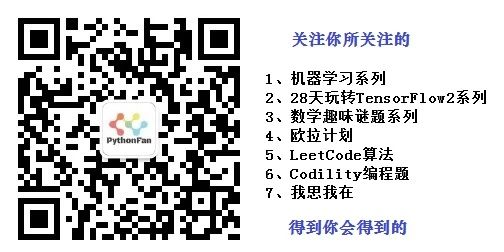Custom MLP model structure, 50 generations, total parameters 119690, Mnist test data set accuracy rate of 98%. For neural networks, May Be Paper is better than width.
The custom MLP structure is as follows:
import numpy as np import tensorflow as tf import os import shutil # mapping from matplotlib import pyplot as plt plt.rcParams['font.family'] = 'SimHei' # Drawing shows Chinese plt.rcParams['axes.unicode_minus']=False # The drawing shows a negative sign print('tensorflow edition:', tf.__version__) import sys print('Python edition:', sys.version.split('|')[0])
tensorflow version: 2.1.0 Python version: 3.7.6
By inheriting the classes defined in TensorFlow, forward transfer output is written, that is, call function is defined. However, it is not necessary to consider the reverse transfer of the model, because the gradient is calculated automatically.
The layer of custom model is that you can build the layer according to your own ideas, instead of calling the built-in model layer of the framework directly. It can be done through tf.keras.Lambda Or inheritance tf.keras.layers The. Layer base class builds a custom model layer.
Note that if variables are involved in the layer created by this method, the variable will not be automatically added to the variable set for gradient calculation. Therefore, if there are parameters to be trained in the user-defined layer, it is recommended to customize the model layer based on the base class. An example is given below:
# Define a fully connected layer: parameters are variables weights = tf.Variable(tf.random.normal((4, 2)), name='w') bias = tf.ones((1, 2), name='b') print(bias) x_input = tf.range(12.).numpy().reshape(-1, 4) # lambda custom layer mylayer1 = tf.keras.layers.Lambda(lambda x: tf.add(tf.matmul(x, weights), bias), name='lambda1') mylayer1(x_input)
tf.Tensor([[1. 1.]], shape=(1, 2), dtype=float32)
WARNING:tensorflow:
The following Variables were used a Lambda layer's call (lambda1), but
are not present in its tracked objects:
<tf.Variable 'w:0' shape=(4, 2) dtype=float32, numpy=
array([[-0.39176947, -1.0340178 ],
[ 1.0816787 , 1.4775925 ],
[ 1.5553304 , 0.8336089 ],
[-0.08553344, 0.4543793 ]], dtype=float32)>
It is possible that this is intended behavior, but it is more likely
an omission. This is a strong indication that this layer should be
formulated as a subclassed Layer rather than a Lambda layer.
<tf.Tensor: shape=(3, 2), dtype=float32, numpy=
array([[ 4.9357395, 5.507948 ],
[13.574565 , 12.434199 ],
[22.213388 , 19.36045 ]], dtype=float32)>
The above warning indicates that the variable named 'w' in this layer is not in the project of calculating gradient. If it is not intended, it is recommended to define the layer based on the base class rather than Lambda.
# Using lambda to build a slightly more complex layer: the back correction layer def lambda_layer(x, name='Inverse correction'): x -= tf.reduce_mean(x, axis=1, keepdims=True) x = tf.math.l2_normalize(x, axis=1) pos = tf.nn.relu(x) neg = tf.nn.relu(-x) return tf.keras.layers.concatenate([pos, neg], axis=1) x_input = tf.range(6.).numpy().reshape(3, 2) lambda_layer(x_input).numpy()
array([[0. , 0.70710677, 0.70710677, 0. ],
[0. , 0.70710677, 0.70710677, 0. ],
[0. , 0.70710677, 0.70710677, 0. ]], dtype=float32)
inherit tf.keras.layers.Layer, which mainly rewrites the init() and call() methods, declares the parameters and functions used in the first method, and defines the output of the layer in the second method. If you need to change the underlying parameters of a layer, such as changing the initial parameters in a fully connected layer, you need to override build(). Here is an example of customizing a full connection layer:
# Customize a full connectivity layer class MyLayerD(tf.keras.layers.Layer): # Inheritance class def __init__(self, outputdim, func, **kwargs): super().__init__(**kwargs) self.output_dim = outputdim # The number of cells in the next layer, self.activatefunc = func # Activation function # Initialization parameters through build def build(self, input_shape): # This function will automatically get the input dimension according to the input data self.w = self.add_weight(name='weights', shape=(input_shape[1], self.output_dim), initializer='uniform', trainable=True) self.b = self.add_weight(name='bias', shape=(1, self.output_dim), initializer='uniform', trainable=True) # Define output def call(self, inputdata): x = tf.add(tf.matmul(inputdata, self.w), self.b) # Full connection output = self.activatefunc(x) # Activation function return output # Construct input data x_input = tf.range(6.).numpy().reshape(2, 3) # Definition layer mylayer2 = MyLayerD(2, tf.nn.relu) # The output of this layer mylayer2(x_input)
<tf.Tensor: shape=(2, 2), dtype=float32, numpy=
array([[0. , 0.10050257],
[0. , 0.05587156]], dtype=float32)>
inherit tf.keras.Model Class, which mainly rewrites the init() and call() methods, declares the parameters and functions used in the first method, and defines the output of this layer in the second method. If you need to show the structure of the model, you need to rewrite the build() method. Here is an example of defining a MLP model:
# Custom MLP class MyModelMLP(tf.keras.Model): def __init__(self, input_shape, **kwargs): super().__init__(**kwargs) self.mylayer1 = MyLayerD(10, tf.nn.relu, name='MyLayer_D1') # Custom layer self.mylayer2 = MyLayerD(20, tf.nn.relu, name='MyLayer_D2') # Custom layer self.layer1 = tf.keras.layers.Dense(30, activation='relu', name='DENSE_1') # Built in full connectivity layer self.mylayer3 = MyLayerD(1, tf.nn.relu, name='MyLayer_D3') # Custom layer # Parameters of the model self.input_layer = tf.keras.layers.Input(input_shape) self.out = self.call(self.input_layer) super().__init__( inputs=self.input_layer,outputs=self.out,**kwargs) # Initialize the parameters of the model def build(self): self._is_graph_network = True self._init_graph_network(inputs=self.input_layer,outputs=self.out) # Define forward passing of model def call(self, inputdata): x = self.mylayer1(inputdata) x = self.mylayer2(x) x = self.layer1(x) x = lambda_layer(x) # Custom Lambda layer output = self.mylayer3(x) return output
2.1 overview of exporting custom models
# Construct input data x_input2 = tf.range(6.).numpy().reshape(2, 3) mymodel1 = MyModelMLP(3, name='MyModelMLP') mymodel1(x_input2) mymodel1.summary()
Model: "MyModelMLP"
__________________________________________________________________________________________________
Layer (type) Output Shape Param # Connected to
==================================================================================================
input_1 (InputLayer) [(None, 3)] 0
__________________________________________________________________________________________________
MyLayer_D1 (MyLayerD) (None, 10) 40 input_1[0][0]
__________________________________________________________________________________________________
MyLayer_D2 (MyLayerD) (None, 20) 220 MyLayer_D1[0][0]
__________________________________________________________________________________________________
DENSE_1 (Dense) (None, 30) 630 MyLayer_D2[0][0]
__________________________________________________________________________________________________
tf_op_layer_Mean (TensorFlowOpL [(None, 1)] 0 DENSE_1[0][0]
__________________________________________________________________________________________________
tf_op_layer_sub (TensorFlowOpLa [(None, 30)] 0 DENSE_1[0][0]
tf_op_layer_Mean[0][0]
__________________________________________________________________________________________________
tf_op_layer_l2_normalize/Square [(None, 30)] 0 tf_op_layer_sub[0][0]
__________________________________________________________________________________________________
tf_op_layer_l2_normalize/Sum (T [(None, 1)] 0 tf_op_layer_l2_normalize/Square[0
__________________________________________________________________________________________________
tf_op_layer_l2_normalize/Maximu [(None, 1)] 0 tf_op_layer_l2_normalize/Sum[0][0
__________________________________________________________________________________________________
tf_op_layer_l2_normalize/Rsqrt [(None, 1)] 0 tf_op_layer_l2_normalize/Maximum[
__________________________________________________________________________________________________
tf_op_layer_l2_normalize (Tenso [(None, 30)] 0 tf_op_layer_sub[0][0]
tf_op_layer_l2_normalize/Rsqrt[0]
__________________________________________________________________________________________________
tf_op_layer_Neg (TensorFlowOpLa [(None, 30)] 0 tf_op_layer_l2_normalize[0][0]
__________________________________________________________________________________________________
tf_op_layer_Relu (TensorFlowOpL [(None, 30)] 0 tf_op_layer_l2_normalize[0][0]
__________________________________________________________________________________________________
tf_op_layer_Relu_1 (TensorFlowO [(None, 30)] 0 tf_op_layer_Neg[0][0]
__________________________________________________________________________________________________
concatenate_1 (Concatenate) (None, 60) 0 tf_op_layer_Relu[0][0]
tf_op_layer_Relu_1[0][0]
__________________________________________________________________________________________________
MyLayer_D3 (MyLayerD) (None, 1) 61 concatenate_1[0][0]
==================================================================================================
Total params: 951
Trainable params: 951
Non-trainable params: 0
__________________________________________________________________________________________________
2.2 structure of output custom model
tf.keras.utils.plot_model(mymodel1, to_file='mymodel1.png', show_shapes=True, show_layer_names=True,rankdir='TB', dpi=100, expand_nested=True)

3 application example of user defined model
Please refer to Content of day 4.
from tensorflow.keras.datasets import mnist mnistdata = mnist.load_data()
(train_features, train_labels), (test_features, test_labels) = mnistdata
# normalization trainfeatures = train_features / 255 testfeatures = test_features / 255
# Tile train_fea = trainfeatures.reshape(-1, 784) test_fea = testfeatures.reshape(-1, 784)
# Using lambda to build a slightly more complex layer: the back correction layer def lambda_layer(x, y): return tf.keras.layers.concatenate([x, y], axis=1)
tf.keras.backend.set_floatx('float64') # Custom MLP class MyMODEL(tf.keras.Model): def __init__(self, input_shape, **kwargs): super().__init__(**kwargs) self.mylayer11 = MyLayerD(64, tf.nn.relu, name='MyLayer_D11') # Custom layer self.mylayer12 = MyLayerD(128, tf.nn.relu, name='MyLayer_D12') # Custom layer self.mylayer21 = MyLayerD(64, tf.nn.relu, name='MyLayer_D21') # Custom layer self.mylayer22 = MyLayerD(128, tf.nn.relu, name='MyLayer_D22') # Custom layer self.dropout1 = tf.keras.layers.Dropout(0.5, name='dropout1') # Built in layer, discard layer, prevent over fitting self.mylayer3 = MyLayerD(10, tf.nn.softmax, name='MyLayer_D3') # Custom layer # Parameters of the model self.input_layer = tf.keras.layers.Input(input_shape) self.out = self.call(self.input_layer) super().__init__( inputs=self.input_layer,outputs=self.out, **kwargs) # Initialized model parameters def build(self): self._is_graph_network = True self._init_graph_network(inputs=self.input_layer,outputs=self.out) # Define forward passing of model def call(self, inputdata, **kwargs): x1 = self.mylayer11(inputdata) x1 = self.mylayer12(x1) x2 = self.mylayer21(inputdata) x2 = self.mylayer22(x2) x = lambda_layer(x1, x2) # Lambda custom layer x = self.dropout1(x) output = self.mylayer3(x) return output
mymodel2 = MyMODEL(784, name='MyModelMLP') mymodel2(train_fea) mymodel2.summary()
Model: "MyModelMLP"
__________________________________________________________________________________________________
Layer (type) Output Shape Param # Connected to
==================================================================================================
input_78 (InputLayer) [(None, 784)] 0
__________________________________________________________________________________________________
MyLayer_D11 (MyLayerD) (None, 64) 50240 input_78[0][0]
__________________________________________________________________________________________________
MyLayer_D21 (MyLayerD) (None, 64) 50240 input_78[0][0]
__________________________________________________________________________________________________
MyLayer_D12 (MyLayerD) (None, 128) 8320 MyLayer_D11[0][0]
__________________________________________________________________________________________________
MyLayer_D22 (MyLayerD) (None, 128) 8320 MyLayer_D21[0][0]
__________________________________________________________________________________________________
concatenate_95 (Concatenate) (None, 256) 0 MyLayer_D12[0][0]
MyLayer_D22[0][0]
__________________________________________________________________________________________________
dropout1 (Dropout) (None, 256) 0 concatenate_95[0][0]
__________________________________________________________________________________________________
MyLayer_D3 (MyLayerD) (None, 10) 2570 dropout1[0][0]
==================================================================================================
Total params: 119,690
Trainable params: 119,690
Non-trainable params: 0
__________________________________________________________________________________________________
tf.keras.utils.plot_model(mymodel2, to_file='mymodel2.png', show_shapes=True, show_layer_names=True, rankdir='TB', dpi=100, expand_nested=True)

Epoch = 50 # Number of iterations of the model Batch_Size = 128 # Number of samples for batch training Out_Class = 10 # The number of output categories, 0-9, 10 categories in total
# Model compilation mYMODEL = MyMODEL(784) mYMODEL.compile(optimizer='Sgd', loss='categorical_crossentropy', metrics=['accuracy']) train_label_cate = tf.keras.utils.to_categorical(train_labels, 10) testlabels = tf.keras.utils.to_categorical(test_labels, 10)
import os checkpoint_path = "./cp-{val_accuracy:.5f}.ckpt" checkpoint_dir = os.path.dirname(checkpoint_path) # Create a callback to ensure the maximum accuracy of the validation dataset cp_callback = tf.keras.callbacks.ModelCheckpoint(filepath=checkpoint_path, save_weights_only=True, monitor='val_accuracy', mode='max', verbose=2, save_best_only=True) # Dynamic change of learning rate: used in model callback def scheduler(epoch): # Dynamically changing the parameters of learning rate according to epoch if epoch < 10: return 0.13 else: return 0.13 * tf.math.exp(0.1 * (10 - epoch)) lr_back = tf.keras.callbacks.LearningRateScheduler(scheduler)
mYMODEL.fit(train_fea, train_label_cate, batch_size=Batch_Size, epochs=Epoch, verbose=2, validation_split=0.1, callbacks=[cp_callback, lr_back])
Train on 54000 samples, validate on 6000 samples Epoch 1/50 Epoch 00001: val_accuracy improved from -inf to 0.92200, saving model to ./cp-0.92200.ckpt 54000/54000 - 4s - loss: 0.9787 - accuracy: 0.6990 - val_loss: 0.2899 - val_accuracy: 0.9220 Epoch 2/50 Epoch 00002: val_accuracy improved from 0.92200 to 0.93950, saving model to ./cp-0.93950.ckpt 54000/54000 - 2s - loss: 0.3452 - accuracy: 0.8996 - val_loss: 0.2039 - val_accuracy: 0.9395 Epoch 3/50 Epoch 00003: val_accuracy improved from 0.93950 to 0.95600, saving model to ./cp-0.95600.ckpt 54000/54000 - 3s - loss: 0.2595 - accuracy: 0.9246 - val_loss: 0.1578 - val_accuracy: 0.9560 Epoch 4/50 Epoch 00004: val_accuracy improved from 0.95600 to 0.96417, saving model to ./cp-0.96417.ckpt 54000/54000 - 3s - loss: 0.2044 - accuracy: 0.9395 - val_loss: 0.1282 - val_accuracy: 0.9642 Epoch 5/50 Epoch 00005: val_accuracy improved from 0.96417 to 0.96900, saving model to ./cp-0.96900.ckpt 54000/54000 - 3s - loss: 0.1720 - accuracy: 0.9496 - val_loss: 0.1132 - val_accuracy: 0.9690 Epoch 6/50 Epoch 00006: val_accuracy improved from 0.96900 to 0.96967, saving model to ./cp-0.96967.ckpt 54000/54000 - 3s - loss: 0.1460 - accuracy: 0.9573 - val_loss: 0.1000 - val_accuracy: 0.9697 Epoch 7/50 Epoch 00007: val_accuracy improved from 0.96967 to 0.97433, saving model to ./cp-0.97433.ckpt 54000/54000 - 3s - loss: 0.1291 - accuracy: 0.9624 - val_loss: 0.0911 - val_accuracy: 0.9743 Epoch 8/50 Epoch 00008: val_accuracy improved from 0.97433 to 0.97450, saving model to ./cp-0.97450.ckpt 54000/54000 - 2s - loss: 0.1140 - accuracy: 0.9657 - val_loss: 0.0855 - val_accuracy: 0.9745 Epoch 9/50 Epoch 00009: val_accuracy improved from 0.97450 to 0.97600, saving model to ./cp-0.97600.ckpt 54000/54000 - 3s - loss: 0.1017 - accuracy: 0.9700 - val_loss: 0.0797 - val_accuracy: 0.9760 Epoch 10/50 Epoch 00010: val_accuracy improved from 0.97600 to 0.97633, saving model to ./cp-0.97633.ckpt 54000/54000 - 3s - loss: 0.0948 - accuracy: 0.9713 - val_loss: 0.0814 - val_accuracy: 0.9763 Epoch 11/50 Epoch 00011: val_accuracy did not improve from 0.97633 54000/54000 - 2s - loss: 0.0848 - accuracy: 0.9748 - val_loss: 0.0832 - val_accuracy: 0.9747 Epoch 12/50 Epoch 00012: val_accuracy improved from 0.97633 to 0.97783, saving model to ./cp-0.97783.ckpt 54000/54000 - 3s - loss: 0.0767 - accuracy: 0.9771 - val_loss: 0.0758 - val_accuracy: 0.9778 Epoch 13/50 Epoch 00013: val_accuracy did not improve from 0.97783 54000/54000 - 2s - loss: 0.0706 - accuracy: 0.9788 - val_loss: 0.0742 - val_accuracy: 0.9777 Epoch 14/50 Epoch 00014: val_accuracy did not improve from 0.97783 54000/54000 - 2s - loss: 0.0641 - accuracy: 0.9808 - val_loss: 0.0746 - val_accuracy: 0.9777 Epoch 15/50 Epoch 00015: val_accuracy improved from 0.97783 to 0.97817, saving model to ./cp-0.97817.ckpt 54000/54000 - 2s - loss: 0.0592 - accuracy: 0.9824 - val_loss: 0.0714 - val_accuracy: 0.9782 Epoch 16/50 Epoch 00016: val_accuracy improved from 0.97817 to 0.97917, saving model to ./cp-0.97917.ckpt 54000/54000 - 2s - loss: 0.0559 - accuracy: 0.9835 - val_loss: 0.0727 - val_accuracy: 0.9792 Epoch 17/50 Epoch 00017: val_accuracy did not improve from 0.97917 54000/54000 - 2s - loss: 0.0530 - accuracy: 0.9843 - val_loss: 0.0689 - val_accuracy: 0.9792 Epoch 18/50 Epoch 00018: val_accuracy improved from 0.97917 to 0.98000, saving model to ./cp-0.98000.ckpt 54000/54000 - 3s - loss: 0.0500 - accuracy: 0.9854 - val_loss: 0.0680 - val_accuracy: 0.9800 Epoch 19/50 Epoch 00019: val_accuracy improved from 0.98000 to 0.98083, saving model to ./cp-0.98083.ckpt 54000/54000 - 3s - loss: 0.0477 - accuracy: 0.9863 - val_loss: 0.0675 - val_accuracy: 0.9808 Epoch 20/50 Epoch 00020: val_accuracy did not improve from 0.98083 54000/54000 - 2s - loss: 0.0459 - accuracy: 0.9862 - val_loss: 0.0681 - val_accuracy: 0.9802 Epoch 21/50 Epoch 00021: val_accuracy did not improve from 0.98083 54000/54000 - 2s - loss: 0.0427 - accuracy: 0.9874 - val_loss: 0.0683 - val_accuracy: 0.9793 Epoch 22/50 Epoch 00022: val_accuracy did not improve from 0.98083 54000/54000 - 2s - loss: 0.0411 - accuracy: 0.9888 - val_loss: 0.0696 - val_accuracy: 0.9797 Epoch 23/50 Epoch 00023: val_accuracy did not improve from 0.98083 54000/54000 - 2s - loss: 0.0406 - accuracy: 0.9880 - val_loss: 0.0676 - val_accuracy: 0.9797 Epoch 24/50 Epoch 00024: val_accuracy improved from 0.98083 to 0.98133, saving model to ./cp-0.98133.ckpt 54000/54000 - 2s - loss: 0.0395 - accuracy: 0.9884 - val_loss: 0.0659 - val_accuracy: 0.9813 Epoch 25/50 Epoch 00025: val_accuracy did not improve from 0.98133 54000/54000 - 2s - loss: 0.0390 - accuracy: 0.9887 - val_loss: 0.0662 - val_accuracy: 0.9803 Epoch 26/50 Epoch 00026: val_accuracy did not improve from 0.98133 54000/54000 - 2s - loss: 0.0368 - accuracy: 0.9895 - val_loss: 0.0664 - val_accuracy: 0.9807 Epoch 27/50 Epoch 00027: val_accuracy did not improve from 0.98133 54000/54000 - 2s - loss: 0.0361 - accuracy: 0.9900 - val_loss: 0.0669 - val_accuracy: 0.9803 Epoch 28/50 Epoch 00028: val_accuracy did not improve from 0.98133 54000/54000 - 2s - loss: 0.0353 - accuracy: 0.9896 - val_loss: 0.0674 - val_accuracy: 0.9807 Epoch 29/50 Epoch 00029: val_accuracy did not improve from 0.98133 54000/54000 - 2s - loss: 0.0346 - accuracy: 0.9900 - val_loss: 0.0665 - val_accuracy: 0.9807 Epoch 30/50 Epoch 00030: val_accuracy did not improve from 0.98133 54000/54000 - 2s - loss: 0.0343 - accuracy: 0.9901 - val_loss: 0.0664 - val_accuracy: 0.9802 Epoch 31/50 Epoch 00031: val_accuracy did not improve from 0.98133 54000/54000 - 2s - loss: 0.0339 - accuracy: 0.9906 - val_loss: 0.0669 - val_accuracy: 0.9812 Epoch 32/50 Epoch 00032: val_accuracy did not improve from 0.98133 54000/54000 - 3s - loss: 0.0337 - accuracy: 0.9903 - val_loss: 0.0676 - val_accuracy: 0.9808 Epoch 33/50 Epoch 00033: val_accuracy improved from 0.98133 to 0.98200, saving model to ./cp-0.98200.ckpt 54000/54000 - 2s - loss: 0.0327 - accuracy: 0.9911 - val_loss: 0.0658 - val_accuracy: 0.9820 Epoch 34/50 Epoch 00034: val_accuracy did not improve from 0.98200 54000/54000 - 2s - loss: 0.0315 - accuracy: 0.9909 - val_loss: 0.0666 - val_accuracy: 0.9812 Epoch 35/50 Epoch 00035: val_accuracy did not improve from 0.98200 54000/54000 - 3s - loss: 0.0320 - accuracy: 0.9907 - val_loss: 0.0660 - val_accuracy: 0.9808 Epoch 36/50 Epoch 00036: val_accuracy did not improve from 0.98200 54000/54000 - 2s - loss: 0.0321 - accuracy: 0.9906 - val_loss: 0.0666 - val_accuracy: 0.9810 Epoch 37/50 Epoch 00037: val_accuracy did not improve from 0.98200 54000/54000 - 2s - loss: 0.0315 - accuracy: 0.9910 - val_loss: 0.0668 - val_accuracy: 0.9817 Epoch 38/50 Epoch 00038: val_accuracy did not improve from 0.98200 54000/54000 - 2s - loss: 0.0312 - accuracy: 0.9915 - val_loss: 0.0668 - val_accuracy: 0.9813 Epoch 39/50 Epoch 00039: val_accuracy did not improve from 0.98200 54000/54000 - 2s - loss: 0.0311 - accuracy: 0.9909 - val_loss: 0.0665 - val_accuracy: 0.9810 Epoch 40/50 Epoch 00040: val_accuracy did not improve from 0.98200 54000/54000 - 2s - loss: 0.0302 - accuracy: 0.9914 - val_loss: 0.0662 - val_accuracy: 0.9817 Epoch 41/50 Epoch 00041: val_accuracy did not improve from 0.98200 54000/54000 - 2s - loss: 0.0304 - accuracy: 0.9916 - val_loss: 0.0666 - val_accuracy: 0.9815 Epoch 42/50 Epoch 00042: val_accuracy did not improve from 0.98200 54000/54000 - 2s - loss: 0.0306 - accuracy: 0.9913 - val_loss: 0.0665 - val_accuracy: 0.9815 Epoch 43/50 Epoch 00043: val_accuracy did not improve from 0.98200 54000/54000 - 3s - loss: 0.0300 - accuracy: 0.9919 - val_loss: 0.0661 - val_accuracy: 0.9820 Epoch 44/50 Epoch 00044: val_accuracy improved from 0.98200 to 0.98217, saving model to ./cp-0.98217.ckpt 54000/54000 - 3s - loss: 0.0305 - accuracy: 0.9920 - val_loss: 0.0662 - val_accuracy: 0.9822 Epoch 45/50 Epoch 00045: val_accuracy did not improve from 0.98217 54000/54000 - 2s - loss: 0.0303 - accuracy: 0.9917 - val_loss: 0.0666 - val_accuracy: 0.9815 Epoch 46/50 Epoch 00046: val_accuracy did not improve from 0.98217 54000/54000 - 3s - loss: 0.0301 - accuracy: 0.9920 - val_loss: 0.0661 - val_accuracy: 0.9817 Epoch 47/50 Epoch 00047: val_accuracy did not improve from 0.98217 54000/54000 - 2s - loss: 0.0291 - accuracy: 0.9921 - val_loss: 0.0663 - val_accuracy: 0.9815 Epoch 48/50 Epoch 00048: val_accuracy did not improve from 0.98217 54000/54000 - 2s - loss: 0.0301 - accuracy: 0.9919 - val_loss: 0.0666 - val_accuracy: 0.9820 Epoch 49/50 Epoch 00049: val_accuracy did not improve from 0.98217 54000/54000 - 2s - loss: 0.0295 - accuracy: 0.9922 - val_loss: 0.0666 - val_accuracy: 0.9813 Epoch 50/50 Epoch 00050: val_accuracy did not improve from 0.98217 54000/54000 - 3s - loss: 0.0301 - accuracy: 0.9917 - val_loss: 0.0666 - val_accuracy: 0.9817 <tensorflow.python.keras.callbacks.History at 0x2ce52908>
# The evaluation model is calculated according to the final parameters of the model test_loss, test_acc = mYMODEL.evaluate(test_fea, testlabels) print('Test data set cost:{:.8f},Accuracy{:.8f}%%'. format(test_loss, 100*test_acc))
10000/10000 [==============================] - 0s 45us/sample - loss: 0.0664 - accuracy: 0.9801 Test data set cost: 0.06635048, accuracy rate 98.01000000%%
# Parameter loading # The new model structure remains consistent. model_new = MyMODEL(784) # It needs to be compiled, and the parameters should be consistent with the original model_new.compile(optimizer='Sgd', loss='categorical_crossentropy', metrics=['accuracy']) # Load trained parameters best_para = tf.train.latest_checkpoint(checkpoint_dir) print('Optimal parameter file:', best_para) model_new.load_weights(best_para) predict_loss, predict_acc = model_new.evaluate(test_fea, testlabels) print('Use the parameters after training','cost:', predict_loss, 'Accuracy', predict_acc)
The optimal parameter file is as follows: cp-0.98217.ckpt 10000/10000 [==============================] - 1s 57us/sample - loss: 0.0663 - accuracy: 0.9800 The parameter cost after training: 0.066284800849457, accuracy 0.98
click Get more project source code. Welcome Follow, thank Star!!! Scan the WeChat official account pythonfan, get more.
